Practice Free 300-410 Exam Online Questions
Refer to the exhibit.
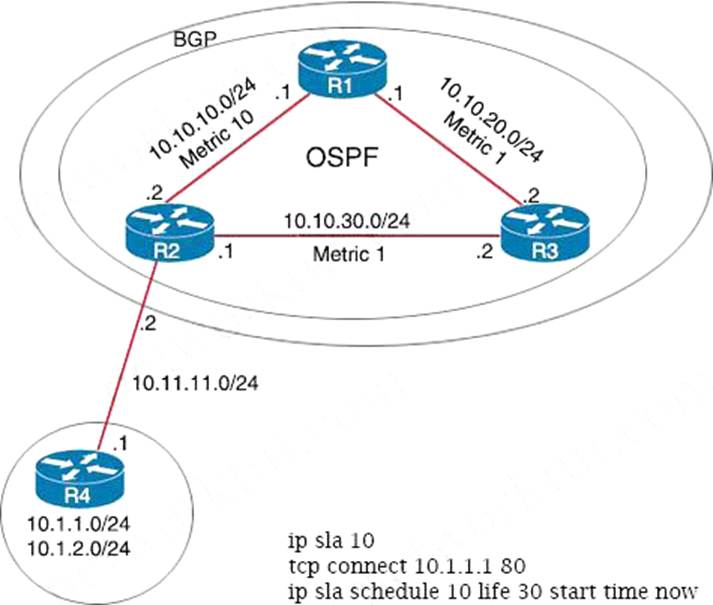
A user has set up an IP SLA probe to test if a non-SLA host web server on IP address 10.1.1.1 accepts HTTP sessions prior to deployment. The probe is failing.
Which action should the network administrator recommend for the probe to succeed?
- A . Re-issue the ip sla schedule command.
- B . Add icmp-echo command for the host.
- C . Add the control disable option to the tcp connect.
- D . Modify the ip sla schedule frequency to forever.
Refer to the exhibit.

Network operations cannot read or write any configuration on the device with this configuration from the operations subnet.
Which two configurations fix the issue? (Choose two.)
- A . Configure SNMP rw permission in addition to community ciscotest.
- B . Modify access list 1 and allow operations subnet in the access list.
- C . Modify access list 1 and allow SNMP in the access list.
- D . Configure SNMP rw permission in addition to version 1.
- E . Configure SNMP rw permission in addition to community ciscotest 1.
Refer to the exhibit.
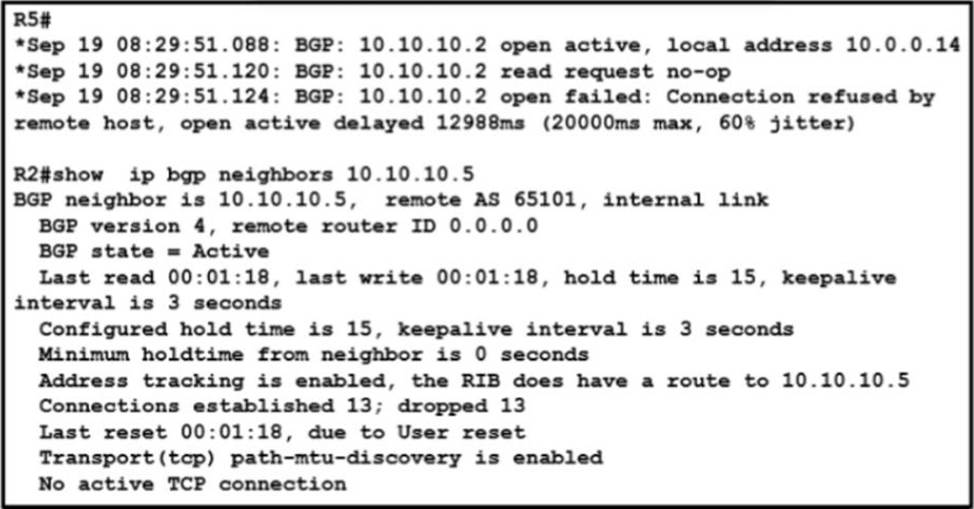
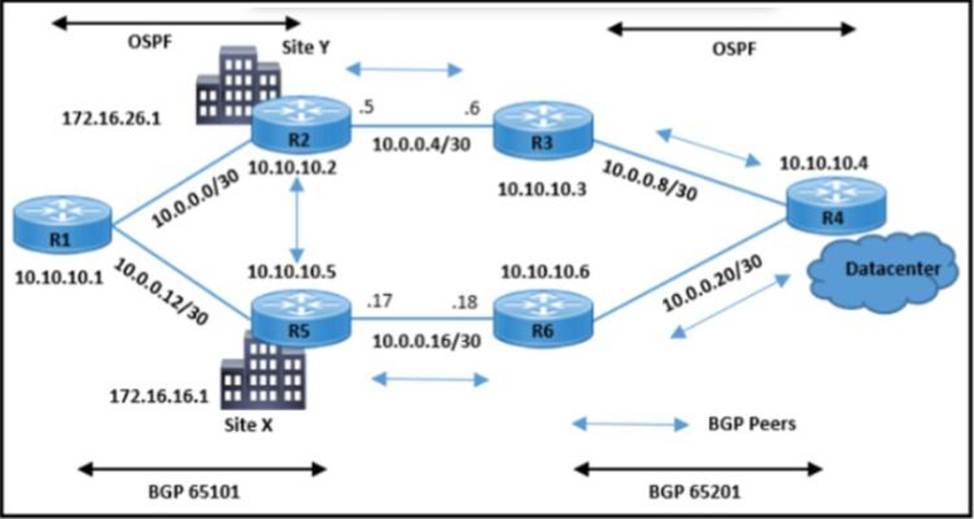
A customer reported a failure and intermittent disconnection between two office buildings site X and site Y The network team finds that site X and site Y are exchanging email application traffic with the data center network.
Which configuration resolves the issue between site X and site Y?
A)
![]()
B)

C)
![]()
D)
![]()
- A . Option A
- B . Option B
- C . Option C
- D . Option D
What are two MPLS label characteristics? (Choose two.)
- A . The label edge router swaps labels on the received packets.
- B . Labels are imposed in packets after the Layer 3 header.
- C . LDP uses TCP for reliable delivery of information.
- D . An MPLS label is a short identifier that identifies a forwarding equivalence class.
- E . A maximum of two labels can be imposed on an MPLS packet.
C,D
Explanation:
Reference: https://www.cisco.com/c/en/us/support/docs/multiprotocol-label-switching-mpls/mpls/4649-mpls-faq-4649.html
Refer to the exhibit.

A network engineer configured routers R1 and R2 with MP-BGP. The engineer noticed that the routers cannot exchange any IPv6 routes, however, the IPv4 neighbor relationship is working fine.
Which configuration must the engineer apply to router R2 to exchange IPv6 routes?
- A . Ipv6cef
I
Interface Loopback100
Ipv6 address 2001: DB8:128::2/128 Interface GigabitEthernet1/0 Ipv6 address 2001:DB8:1::2/64
I
router bgp 65002
no bgp default ipv4-unlcast
neighbor 2001: DB8:1::1 emote-as 65001
I
address-family ipv6
network 2001:DB8:128::2/128
neighbor 2001:DB8:1::1 activate - B . Ipv6 unicast-routing ipv6 cef
Interface Loopback100
ipv6 address 2001: DB8:12C:2 129
I
interface GigabitEthernet1/0 ipv6 address 2001: DB8:1::2 64 description AS65001 ID B466:A83D:3D7::1
!
router bgp 65002
no bgp default Ipv4-unicast
neighbor 2001: DB8:1::1 remote-as 65001
!
address-family Ipv4
neighbor 2001:DB8:1::1 activate - C . Ipv6 unicast-routing
ipvG cef
I
Interface Loopback100
Ipv6 address 2001:DB8:128::2/128 I interface GigabitEthernet1/0
ipv6 address 2001:DB8:1::2/64
!
router bgp 65002 no bgp default ipv4-unicast neighbor 2001: DB8:1::1 remote-as 65001
!
address-family ipv6 network 2001:DB8:128::2I128 - D . Ipv6 unicast-routing Ipv6 cef
I
interface Loopback100
ipv6 address 2001: DB8:128::2/128
!
interface GigabitEthernet1/0 ipv6 address 2001:DB8:1::2/64 i
router bgp 65002 no bgp default ipv4-unicast neighbor 2001: DB8:1::1 remote-as 65001
!
address-family ipv6
network 2001:DB8:128::2/128 neighbor 2001:DB8:1::1 activate
Refer to the exhibit.
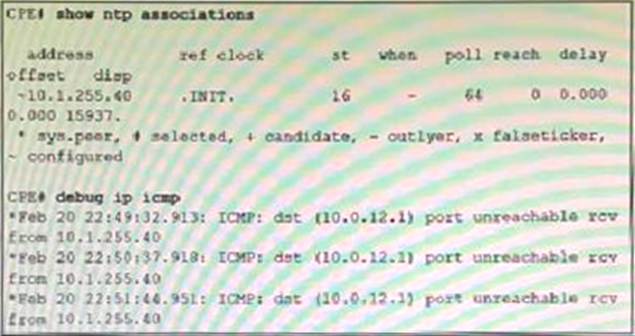
An administrator is troubleshooting a time synchronization problem for the router time to another Cisco IOS XE-based device that has recently undergone hardening.
Which action resolves the issue?
- A . Allow NTP in the ingress ACL on 10.1.225.40 by permitting UDP destined to port 123.
- B . Ensure that he CPE router has a valid route to 10.1.255. 40 for NTP and rectify if not reachable.
- C . NTP service is disabled and must be enabled on 10.1.225.40.
- D . Allow NTP in the ingress ACL on 10.1.255.40 by permitting TCP destined to port 123.
How does an MPLS Layer 3 VPN function?
- A . set of sites use multiprotocol BGP at the customer site for aggregation
- B . multiple customer sites interconnect through service provider network to create secure tunnels between customer edge devices
- C . set of sites interconnect privately over the Internet for security
- D . multiple customer sites interconnect through a service provider network using customer edge to provider edge connectivity
D
Explanation:
A Multiprotocol Label Switching(MPLS) Layer 3 Virtual Private Network (VPN) consists of a set of sites that are interconnected by means of an MPLS provider core network. At each customer site, one or more customer edge (CE) routers attach to one or more provider edge (PE) routers.
Reference: https://www.cisco.com/c/en/us/td/docs/routers/asr9000/software/asr9k-r6-5/lxvpn/configuration/guide/b-l3vpn-cg-asr9000-65x/b-l3vpn-cg-asr9000-65x_chapter_010.pdf
Refer to the exhibit.
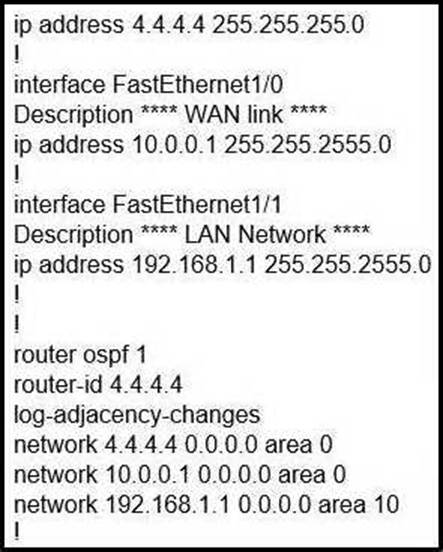
A)
![]()
B)
![]()
C)
![]()
D)
![]()
- A . Option
- B . Option
- C . Option
- D . Option
Refer to the exhibit.

The OSPF neighbor relationship is not coming up.
What must be configured to restore OSPF neighbor adjacency?
- A . OSPF on the remote router
- B . matching hello timers
- C . use router ID
- D . matching MTU values
What is an MPLS LDP targeted session?
- A . session between neighbors that are connected no more than one hop away
- B . LDP session established between LSRs by exchanging TCP hello packets
- C . label distribution session between non-directly connected neighbors
- D . LDP session established by exchanging multicast hello packets
